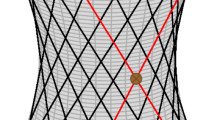Abstract
Computer graphics is ostensibly based on projective geometry. The graphics pipeline—the sequence of functions applied to 3D geometric primitives to determine a 2D image—is described in the graphics literature as taking the primitives from Euclidean to projective space, and then back to Euclidean space.
This is a weak foundation for computer graphics. An instructor is at a loss: one day entering the classroom and invoking the established and venerable theory of projective geometry while asserting that projective spaces are not separable, and then entering the classroom the following week to tell the students that the standard graphics pipeline performs clipping not in Euclidean, but in projective space—precisely the operation (deciding sidedness, which depends on separability) that was deemed nonsensical.
But there is no need to present Blinn and Newell’s algorithm (Comput. Graph. 12, 245–251, 1978; Commun. ACM 17, 32–42, 1974)—the crucial clipping step in the graphics pipeline and, perhaps, the most original knowledge a student learns in a fourth-year computer graphics class—as a clever trick that just works. Jorge Stolfi described in 1991 oriented projective geometry. By declaring the two vectors \((x,y,z,w)^{{\ensuremath {\mathsf {T}}}}\) and \((-x,-y,-z,-w)^{{\ensuremath {\mathsf {T}}}}\) distinct, Blinn and Newell were already unknowingly working in oriented projective space. This paper presents the graphics pipeline on this stronger foundation.
Similar content being viewed by others
Explore related subjects
Discover the latest articles and news from researchers in related subjects, suggested using machine learning.References
Bell, E.: Men of Mathematics. Simon & Schuster, New York (1937)
Blinn, J.: A trip down the graphics pipeline: line clipping. IEEE Comput. Graph. Appl. 11(1), 98–105 (1991)
Blinn, J.: A trip down the graphics pipeline: the homogeneous perspective transform. IEEE Comput. Graph. Appl. 13, 75–80 (1993)
Blinn, J., Newell, M.: Clipping using homogeneous coordinates. Comput. Graph. 12, 245–251 (1978)
Bloomenthal, J., Rokne, J.: Homogeneous coordinates. Vis. Comput. 11, 15–26 (1994)
Boyer, C.: History of Analytic Geometry. Dover, New York (2004)
Coxeter, H.: Projective Geometry, 2nd edn. Springer, New York (1987)
Coxeter, H.: Non-Euclidean Geometry, 6th edn. MAA, Washington (1998)
Crowe, M.: A History of Vector Analysis. Dover, New York (1994)
Ghali, S.: Introduction to Geometric Computing. Springer, New York (2008)
Goldman, R.: On the algebraic and geometric foundations of computer graphics. ACM Trans. Graph. 21(1), 52–86 (2002)
Hartley, R.: Chirality. Int. J. Comput. Vis. 26(1), 41–61 (1998)
Hartley, R., Zisserman, A.: Multiple View Geometry in Computer Vision. Cambridge University Press, Cambridge (2004)
Herman, I.: The Use of Projective Geometry in Computer Graphics. Springer, New York (1992)
Hilbert, D.: The Foundations of Geometry. The Open Court Publishing Company, Chicago (1902)
Hill, F.: Computer Graphics, 2nd edn. Prentice-Hall, New York (2001)
Kline, J.: Double elliptic geometry in terms of point and order. Ann. Math. 18(1), 31–44 (1916)
Laveau, S., Faugeras, O.: Oriented projective geometry for computer vision. In: European Conference on Computer Vision (1996)
Penna, M., Patterson, R.: Projective Geometry and Its Applications to Computer Graphics. Prentice-Hall, New York (1986)
Riesenfeld, R.: Homogeneous coordinates and projective planes in computer graphics. IEEE Comput. Graph. Appl. 1(1), 50–55 (1981)
Roberts, L.: Machine perception of three-dimensional solids. In: Tippett, J., et al. (eds.) Optical and Electro-Optical Information Processing, pp. 159–197. MIT Press, Cambridge (1965). Also published in Rosalee Wolfe, ed., Seminal Graphics, Pioneering Efforts that shaped the Field, ACM Press, 1998 and as MIT Lincoln Laboratory, TR 315 (May 1963)
Semple, J., Kneebone, G.: Algebraic Projective Geometry. Oxford University Press, Oxford (1952)
Stolfi, J.: Oriented Projective Geometry: A Framework for Geometric Computations. Academic, New York (1991)
Sutherland, I., Hodgman, G.: Reentrant polygon clipping. Commun. ACM 17, 32–42 (1974)
Author information
Authors and Affiliations
Corresponding author
Rights and permissions
About this article
Cite this article
Ghali, S. Sense and sidedness in the graphics pipeline via a passage through a separable space. Vis Comput 25, 367–375 (2009). https://doi.org/10.1007/s00371-008-0302-4
Published:
Issue Date:
DOI: https://doi.org/10.1007/s00371-008-0302-4




